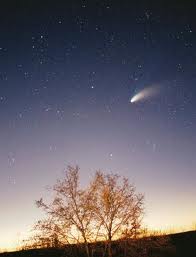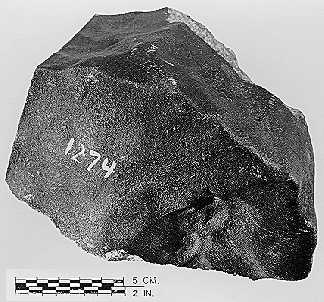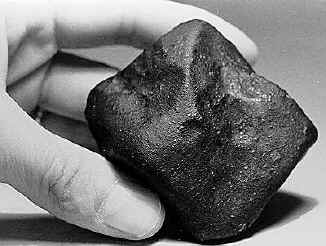 At one time or another, almost everyone in Maine has glimpsed a swift little streak of light dashing across the night sky. These are meteors, commonly called falling or shooting stars. Because they arrive at very high speeds – anywhere from 7 to 46 miles per second – they vaporize by air friction in a white-hot streak. Occasionally a larger object will survive its descent through the atmosphere and fall to Earth. At that point it is called a meteorite and becomes part of Maine’s geology.
At one time or another, almost everyone in Maine has glimpsed a swift little streak of light dashing across the night sky. These are meteors, commonly called falling or shooting stars. Because they arrive at very high speeds – anywhere from 7 to 46 miles per second – they vaporize by air friction in a white-hot streak. Occasionally a larger object will survive its descent through the atmosphere and fall to Earth. At that point it is called a meteorite and becomes part of Maine’s geology.
What is a meteorite?
A meteorite is a chunk of metallic or stony material from space that strikes the surface of the Earth. These rocks originated in the asteroid belt, on the Moon, and from other planets. Rocks blasted off any such parent bodies, by impact or collision, will orbit the Sun just as the planets do. A small fraction of these orbiting rocks cross the Earth’s orbit, and coming under the influence of Earth’s gravity, may fall into our atmosphere. If they survive this fiery descent to Earth, they become meteorites.
There are three kinds of meteorites: stony, iron, and stony-iron. The size of meteorites varies greatly. Most of them are relatively small. The largest meteorite ever found weighs about 60 metric tons.
Meteorites reach the Earth’s surface because they are the right size to travel through the atmosphere. If objects from space are too small, they will disintegrate in the atmosphere. If they are too large, they may explode before reaching Earth’s surface.
Maine Meteorites
Though many meteorites probably have landed in Maine, only 5 have been found and confirmed scientifically, and portions of each are preserved in museum collections. Four of these were actually observed falling from the sky, and were collected shortly thereafter.
Meteorites are named for geographic features near the sites where they are found.
Nobleboro Meteorite
Maine’s first recorded meteorite (and the second recorded in the United States) arrived shortly after statehood, between 4 and 5 PM on August 7, 1823 at Nobleboro by a Mr. A. Dinsmore. Mr. Dinsmore thought he heard musket fire and saw a small whitish cloud spiraling earthward which made a noise “like a whirlwind stirring leaves.” Something struck the ground nearby, startling a flock of sheep. Mr. Dinsmore dug down half a foot and found 5 or 6 pounds of a sulphrous-smelling material.
Almost 100 grams of the original mass is preserved in museum collections worldwide. The Nobleboro meteorite is of the achondrite type that account for only 3% of all meteorites recovered. This makes the Nobleboro specimen the most interesting of Maine meteorites to scientists.
Castine meteorite
The second Maine meteorite fell at about 4:15 AM on Saturday May 20, 1848 near the village of Castine. A single stone, reported as “not larger than a hen’s egg” weighing 42 grams was found by Mr. Charles Blaisdell. An account of this chondrite-type meteorite was published by Shepard (1848) in the American Journal of Science. Pieces of this meteorite have been distributed to museums all over the world. T
Searsmont meteorite
At about 8:15 AM on Sunday May 21, 1871 a third Maine meteorite fell at Searsmont. The following is a description of the event reported to a local paper which is quoted by Shepard (1871).
“There was first heard an explosion, like the report of a heavy gun, followed by a rushing sound resembling the escape of steam from a boiler. The sound seemed to come from the south, and to move northwardly. The stone fell in the field of Mr. Bean, the flying earth being seen by Mrs. Buck, who lives near. The hole that it made was soon found and the stone dug out. It was quite hot and so much broken as to be removed only in pieces. The outside shows plainly the effect of melting heat. It struck with such force as to penetrate the hard soil to a depth of two feet.”
The total weight of the known specimens of the Searsmont meteorite is about 2 pounds.
Andover meteorite
The fourth Maine meteorite landed at Andover on August 5, 1898. It fell on the farm of Lincoln Dresser who said of the event “It came from the north west and it was accompanied by a loud noise resembling a buzz saw, and had a following of smoke….. I secured, by digging, a large piece weighing 7+ pounds, and two or three small ones which were broken by its striking the rock fence.” (Ward, 1903)
The main mass of the Andover meteorite, now weighing 2791 grams is housed in the collection of the Smithsonian Institution.
Walnut Hill Meteorite
Only one practically unknown meteorite was recovered in Maine in the twentieth century.
A newspaper report in 1978 described a discovery of a meteorite in the town of North Yarmouth. While repairing the roof of a brooding shed on his father’s poultry farm, Mark L. Smith noticed a hole near the eaves. He found a small black stone lying a few inches below the top of the plate. The Smiths took it to the University of Southern Maine where it was identified as a meteorite.
The Walnut Hill meteorite is an ordinary chondrite, and is completely covered by a thin black fusion crust formed by melting of the outer layer as it fell through the atmosphere. It weighs 218 grams.
Condensed from “Meteorites in Maine: Is the sky falling???” Maine Geological Survey. Maine Department of Conservation. Originally published in March 1999. See http://www.state.me.us/doc/nrimc/mgs/explore/minerals/sites/mar99.htm
Additional Resources
Francis, C.A., 2000, Maine Meteorites, in Mineralogy of Maine, Volume 2: Mining History, Gems, and Geology, Maine Geological Survey, 7 p.
Dodd, R.T., 1986, Thunderstones and shooting stars: the meaning of meteorites: Harvard University Press. Cambridge, Massachusetts, 196 p.
McSween, H.Y., Jr., 1987, Meteorites and their parent planets: Cambridge University Press, New York, 237 p.
Shepard, C.U., 1848, An account of the meteorite of Castine, Maine, May 20, 1848: American Journal of Science, second series, v. 6, p. 251-253.
Shepard, C.U., 1871 Notice of the meteoritic stone of Searsmont, Maine: American Journal of Science, third series, v.2, p. 200-210.
Ward, H.A., 1903, The Andover meteorite: American Journal of Science, fourth series, v. 15, p. 395-396.



